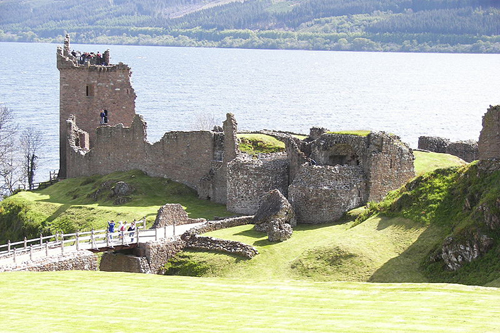THE LOCH Ness Monster faces months of broken slumber – as restoration work is set to start at one of the area’s top viewing points.
Urquhart Castle dominates a rocky outcrop which juts out into Loch Ness, and is a popular vantage points for visitors to scan the tranquil waters for Nessie.
It has been the site of dozens of sightings of the legendary monster, including as recently as several months ago when tourists spotted a “black object” moving in the water.
It has survived capture by Edward I of England, provided a base for government troops during the Jacobite rising, and was even partially blown up by soldiers to prevent the rebels using it.

But now, a contractor is being sought to build high-level scaffolding for repairs to the 13th-century castle.
Historic Environment Scotland (HES) is planning to refurbish the upper levels of the tower at the beginning of next year, and aims to complete the work in time for the start of the busy summer tourist season.
Scaffolding is required around the Grant Tower, which stands five storeys high, to allow for masonry consolidation works and to remove corroded steel beams within the chamber above the first floor.
It will be erected in January for the work to start in February, with the hope that the repairs will be finished in May.
A spokeswoman for HES said disruption to tourists would be kept to a minimum.
“The work will be carried out by our Monument Conservation Unit using traditional skills and materials, and will involve the replacement of beams as well as the consolidation of masonry,” she said.
“We will ensure that disruption to visitors is kept to a minimum, and hope to have work completed in May.”
Earlier this year, tourists visiting the castle claimed they had spotted a “big black belly” disappearing under the loch, leaving behind a whirlpool in the water.
A video taken by the visitors shows a black object moving slowly in the water before disappearing into the depths.
The castle itself has an extensive history, surviving a plethora of attacks and forever-changing inhabitants.
In 1296 the castle was captured by Edward I of England, and from then on it was passed back and forth between Scottish and English control.
In 1332, following King Robert the Bruce’s death, it remained the only Highland castle holding out against English invaders.
After the cross-border threat evaporated, the MacDonalds, Lords of the Isles, repeatedly swept through Glen Urquhart in their quest for more power.
James IV gave the barony of Urquhart to the Grant family in 1509, and at some point during that century the Grants built the five-storey tower known as the Grant Tower.
In 1688, the Catholic King James VII was driven into exile and the crown passed jointly to his Protestant daughter Mary II and her husband William of Orange, which prompted the first of the Jacobite risings.
The Jacobites commanded much of their support in the Highlands, so Urquhart was duly garrisoned with government forces.
They remained for more than two years, and when the last soldiers marched out in 1692, they blew it up.
The castle soon fell into decay and during the 1800s the ancient stronghold came to be viewed as a noble ruin in a majestic setting.
It passed into state care in 1913, and is now one of the most visited of all Scotland’s castles.
